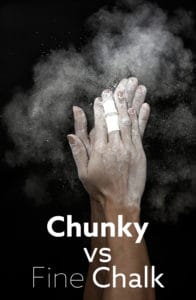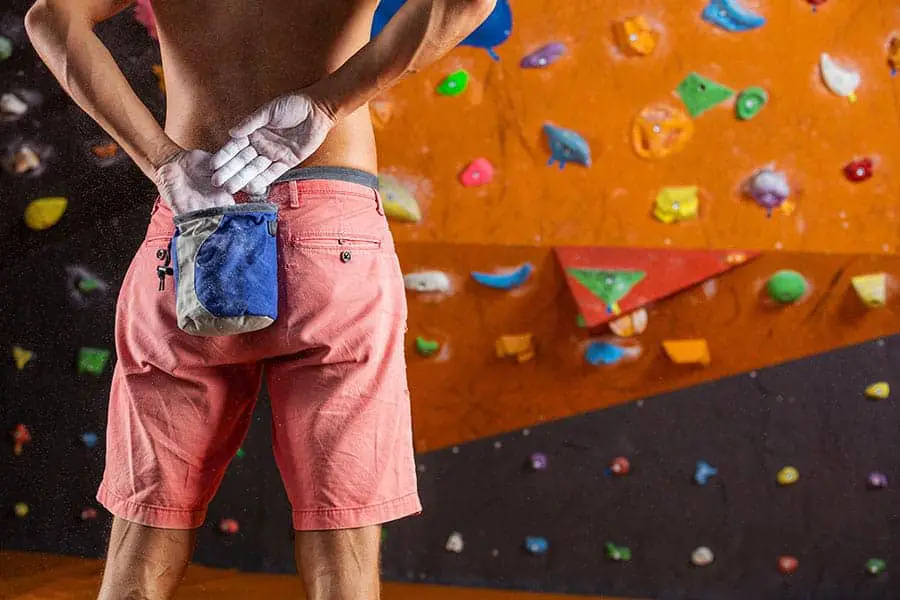When it comes to climbing, chalk is one of the most popular tools used by climbers to give them the edge they need to climb higher and harder.
Chalk used to only be provided in a block form (still common in most CrossFit and weightlifting competitions) but now you can get it in a liquid form, or the most common way in climbing, in a powder form.
Climbing chalk powder ranges from super chunky to super fine chalk. Basically, chunky chalk is clumps of a chalk block that has been broken down into smaller pieces and fine chalk is chalk that has been ground down to tiny dust particles.
A couple of days ago I published a poll that asked women climbers if they prefer chunky or fine chalk. Of the 79 respondents, 49 said that they prefer fine chalk over the 30 who prefer chunky chalk.
Below is a broader conversation about the differences between the two chalk types and also feedback from climbers about why they prefer the chalk that they prefer.
Chunky Chalk
Chunky chalk, as mentioned above is basically a block of chalk that has been broken into smaller pieces.
Cost of Chunky Chalk
When it comes to cost, a quick search on Amazon will show you that chunky chalk is more accessible and cheaper than fine chalk. This is likely because it is easier to make chunky chalk than it is to make fine chalk.
However, the cost of chunky chalk varies greatly between brands. This is interesting because most chalk is made from the same ingredients (magnesium carbonate) and very few brands have added ingredients such as Black Diamond Black Gold that has added Upsalite or Joshua Tree that adds essential oils.
So why is the same chalk (magnesium carbonate) cost vary so much? Though I don’t have the answer to that question, one could speculate that the more favorable a brand is, the more likely you are willing to pay a higher price for it. Thus, the cost varies based on what the public is willing to pay, not how much it is worth.
Chunky Chalk Waste
Unfortunately, chalk doesn’t all get on your hands when you “chalk up.” It also gets all over the rock face, the floor and even your belay partners’ hair. This excess of chalk is considered waste, because it is not being used for the intended purpose of drying out your hands.
Many respondents to my poll who suggested they prefer chunky chalk mentioned that they feel like chunky chalk is less likely to be wasted compared to fine chalk.
This is likely the case because the chunks of chalk are heavier and therefore are more likely to remain in the chalk bag compared to fine chalk that is light and may disperse into the air like dust being blown off of an old book.
In addition, climbers explained that the action of crushing the chalk into their hands may also make it so the chalk remains on the hands longer and better than if they used fine chalk.This may also be an indication that chunky chalk is harder to waste or easier to get the most use out of.
Application of Chunky Chalk
One of the biggest differences between chunky chalk and fine chalk is the way that you apply it to your hands.
To apply chunky chalk to your hands, you usually grab a couple of clumps in your hand and while your hand is still in the chalk bag, you crush the clumps in your fingertips.
The crushing action smashes the chalk into your fingertips and leaves a layer of chalk on your hand when you take your hand out of the chalk bag.
When it comes to chunky chalk, this varies slightly based on how big the chunks of chalk are. For example, if the chunks are small pebbles, you will likely rub your hands together in a friction motion to crush the chunks into your hand.
However, if the chunks are bigger, you’ll likely crush the big chunks in your fingers ov er and over until you have the amount needed for climbing.
Eventually, you’ll be left with small pebbles and powder chalk, at which point most climbers that prefer chunky chalk will refill their supply.
Climbers Perspective of Chunky Chalk
As mentioned earlier, chunk chalk wasn’t as popular in my poll among female climbers, however, there were a lot of comments defending their preference.
One climber said that they prefer pea-sized pieces because it is fun to crumble in your hands. They said that they “like the tactile nature of pea chunks.” Not surprisingly, many other climbers agreed.
Aside from the fun that climbers get from crushing chunky chalk, many climbers explained that they like the minimal waste (see Chunky Chalk Waste above). One climber, for example, mentioned that when they are pumped and reapplying chalk, they don’t have to be as careful or worry about wasting chalk if it is chunky.
Some of the respondents to my poll noted that they prefer chunky chalk because they don’t like how fine chalk is made of such small particles that it seems to get under their fingernails easier
Fine Chalk
Fine chalk is magnesium carbonate that gets ground down to fine dust. Because of this process, the fine chalk is also softer to touch and according to my poll, fine chalk is preferable for climbers.
Cost of Fine Chalk
Fine chalk is generally more expensive than chunky chalk and it is also a little bit less accessible compared to chunky chalk (though there is plenty available). The cost difference, like I mentioned in the chunky section is likely because it is more difficult and more costly to produce.
To ground down the chalk, you have to do more than just smash a few blocks of chalk. You also have to filter through it and ensure that no chunks get through. Because of this additional process, you also need additional quality assurance checks. All of this adds up to more labor cost, more machines needed to produce it and to top it all off, it is a longer process.
The cost of fine chalk varies by brand and some fine chalk seems softer than others (probably a quality assurance issue).
In addition to fine chalk being more expensive, you usually have to buy more because there is more waste, making it even more expensive than what you see at face value (see below).
Fine Chalk Waste
According to my poll, the biggest reason why some climbers don’t like fine chalk is because it is so easy to waste. The light dust that makes fine chalk so desirable is also what makes it so wasteful. Because the chalk dust is light, it is more likely to go up in a cloud and disperse everywhere.
In addition, when you dunk your hand in the chalk and raise your hand out, any excess dust that isn’t firmly compressed into your fingers will disperse.
When you watch a bouldering or climbing competition and you see the climber put chalk on their hands and then blow their hands (essentially removing any excess chalk), that cloud of chalk is wasted.
Application of Fine Chalk
The application fo fine chalk is not only the biggest difference between chunky and fine chalk, it is also one of the biggest reasons why climbers love fine chalk, according to my poll.
To apply fine chalk, you dip your fingertips in your chalk bag full of soft and fine chalk, then you pull out your hand and start climbing. Some climbers will also blow any excess chalk off their hands before continuing to climb.
In addition to the process being faster and easier to apply fine chalk compared to chunky chalk, there is also the feeling that climbers describe when they dip their hands in the chalk bag. Dipping your hand into fine chalk feels like petting something soft.
Some Friction Lab lovers even suggest that it is like what they imagine petting a unicorn to feel like, pure bliss. That’s fitting because Friction Lab has a picture of a unicorn on their ultra-fine chalk packaging.
Climbers Perspective of Fine Chalk
Overall, climbers that prefer fine chalk feel that the cost and waste aspects of fine chalk is outweighed by how easy and soft the application of fine chalk is.
However, many climbers (who prefer chunky chalk) mentioned that they felt like fine chalk leaks out of your bag easily and it even feels like they might be breathing it in more compared to chunky chalk.
There has been little research about breaking in chalk and/or if it is damaging, but it is still a common concern among climbers.
With that being said, there were substantially fewer people defending their stance of using fine chalk in my poll than those that used chunky chalk, so it is hard to get a solid read on the views of all of the respondents.
Is There A Happy Medium?
Long story short, yes. Many brands have combined fine chalk with chunky chalk. This is likely because it is easier to produce when you don’t have to filter out chunks or fine chalk. However, the happy medium usually comes from climbers purchasing their favorite chunky chalk and combining it with their favorite fine chalk at whatever ratio they prefer.
If they like the tactile feel of crushing chunky chalk, then they probably add more chunky chalk to their mix than fine chalk.
If they prefer the soft and easy application of fine chalk, then they probably add more fine chalk to their chalk mix than chunky chalk.
This personalized combination makes for the perfect/happy medium between the two types of chalk.
More Buyer’s Guides:
- The Top 5 Crash Pads For Bouldering: How To Decide Which Is Best
- Diy Hangboard With Jugs And Edges For Less Than $15
- 6 Of The Best Belay Devices For Beginner Climbers
- The Best 11 Climbing Shoes Under $100
- Climbing Chalk: Chunky Vs. Fine
- The Best Chalk For Climbing And Bouldering
- Rock Climbing Starter Kits For Beginners Compared
- Liquid Chalk Vs. Dry Chalk For Bouldering (Hint: Dry Chalk Is Better)
- Top 5 Gear You Need In Your Climbing Pack For The Best Experience
- What To Wear While Bouldering
- Should You Upgrade To An Assisted-Braking Belay Device?
- Everything You Need To Know About Climbing Chalk
- 37 Things Serious Climbers Bring With Them To The Mountains
- Clothing For Climbing In The Gym – What Should You Wear?
- Can You Climb Without Chalk?
- How Tight Climbing Shoes Should Fit For The Best Performance
- Harnesses For Rappeling
- My Favorite Harness For Climbing
- What You Should Wear While Climbing
- What Affects How Climbing Shoes Fit?
- How To Clean Your Grigri
- How To Care For Your Climbing Rope



